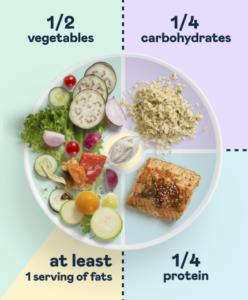Jump to: How can you lose belly fat? | Stress management to reduce cortisol | Improving diet to reduce insulin resistance | Exercise to lower insulin resistance and cortisol levels | Take home message
How can you lose belly fat?
You’ll often find online articles and videos claiming to hold the secret to losing belly fat in ‘5 quick steps’, ‘by taking these expensive supplements’, or ‘by doing 1000 crunches or sit-ups a day’.
Unfortunately, there’s no quick-fix solution for fat loss and eliminating your belly fat.
The reasons for weight gain and why your body stores excess fat in this region are multi-faceted and complex and can depend on many lifestyle factors like how many hours of sleep you get and whether you’re eating a healthy diet.
But we can break them down into three root causes:
- Genetics
- Insulin resistance
- High cortisol levels
Unfortunately, we’re unable to change your genetics. Still, we can improve insulin resistance and lower your cortisol levels through changes in your lifestyle, such as improved stress management, increased physical activity, and diet.
Waist circumference is an indicator of the amount of fat stored in and around your internal organs; while commonly referred to as your belly fat, the technical terms are abdominal fat and visceral fat. We’ll use these terms interchangeably throughout the article.
Higher visceral fat levels in your midsection are associated with many chronic conditions such as type 2 diabetes, fatty liver, and heart disease.
At Second Nature, we take a holistic approach to health and provide support from a registered nutritionist or dietitian five days a week to help you reduce insulin resistance, lose your belly fat, and reach a healthy weight.
If you’d like to try us out, take our health quiz here.
Otherwise, keep reading to find evidence-based solutions to reduce your waistline and that stubborn belly fat, and improve your health in the long term.
Medication-assisted weight loss with a future focus
Start with Wegovy or Mounjaro, transition to habit-based health with our support


1) Stress management to reduce cortisol
Stress is a complicated topic. We’ve previously been told that stress is bad for our health, and we must reduce it at all costs.
While managing stress and ensuring a positive work-life balance is essential, we might also benefit from embracing the positive side of stress.
In her TED talk, Kelly McGonigal – a psychologist from the University of Stanford – outlines the scientific evidence showing how people who embrace stress as an opportunity to learn, improve, and better themselves, are more likely to live longer and score higher on quality of life scores.
This was illustrated by a study that tracked people over time to see how their perception of stress impacted their mortality risk.
It showed that people who rated themselves as having high levels of stress but believed it was positive had a 17% lower risk of death than those who viewed it as a negative.
So how can you make stress your friend? Use positive affirmations
Our brains are wired to think negatively, and because we’ve been conditioned to believe stress is bad for us, the first thoughts that come to mind when we feel stressed are often negative.
However, research has shown that we can train our brain to think more positively, ultimately changing how our body reacts to stress. The next time you feel stressed or have strong emotions, repeat some of the following affirmations:
- My heart is racing because it’s pumping oxygen around my body to prepare me to perform.
- I feel hot and sweaty because my body’s releasing energy into my bloodstream to help me perform.
- This situation is stressful, but my body will give me the courage to respond, learn, and adapt.
Embracing calm too
While embracing stress can positively impact how you manage it in the long term, it also helps to embrace opportunities to have some downtime. This has also been proven to reduce cortisol levels and improve stress management.
Calming activities that have been shown to reduce circulating cortisol levels include accessing nature, social bonding, and mindfulness meditation.
Key points:
- Reducing cortisol levels will help to lower visceral fat storage.
- Our brains are wired to think negatively, and we’ve been conditioned to believe that stress is bad for us.
- Research shows that embracing stress and using it as an opportunity to learn and adapt can benefit long-term health.
- Positive affirmations are a way of improving your relationship with stress.
- Accessing nature, social bonding, and mindfulness meditation are all proven ways to improve stress management and lower cortisol levels.
2) Improving diet to improve insulin resistance
A healthy diet isn’t just about eating fewer calories. Leading theories of insulin resistance suggest that diets high in ultra-processed foods, particularly refined carbohydrates and sugar, are the leading cause of the development of insulin resistance and increased body fat.
Insulin is a hormone that helps the body manage blood sugar (glucose) and fat levels in the blood. When your body’s cells develop insulin resistance, insulin can no longer do its job effectively.
While associated with obesity, you don’t have to be overweight to have insulin resistance.
Excess sugar – particularly from added sugars like those found in sodas and fruit juice – and fat get transported into the liver and around your internal organs to be stored as visceral fat, even in lean individuals.
A lower-carbohydrate diet is typically higher in protein and fat and lower in starchy carbohydrates such as cereals, pasta, rice, and bread. It also prioritises high-fibre carbohydrates such as whole grains, potatoes, and fruit.

Lower-carbohydrate diets have been shown to lower insulin resistance, visceral fat levels, and cravings for ultra-processed foods.
A study compared a lower-carb, higher-fat diet to a low-fat diet to determine their effect on levels of visceral fat stored in the liver after 8-weeks.
The lower-carb diet reduced liver fat content by 29%, whereas the low-fat diet reduced liver fat by just 4%. Interestingly, no weight loss was observed in either group, suggesting that weight loss is not required to achieve this improvement through a lower-carb diet.
Lower-carb diets seem to work by helping to lower your calorie intake, which supports your body burn through excess stomach fat.
Click here to get a free NHS-approved lower-carb meal plan from Second Nature.
Key points:
- Insulin resistance can lead to increased visceral fat storage.
- Leading theories suggest that insulin resistance can be caused by diets high in refined carbohydrates and sugars.
- Lower-carbohydrate diets have been shown to effectively lower insulin resistance and visceral fat storage levels compared to low-fat diets.
3) Exercise to lower insulin resistance and cortisol levels
Exercise has many health benefits; it isn’t just about helping you burn calories.
It can be an extremely effective tool to help you lose belly fat long-term as it improves insulin resistance and high cortisol levels. Exercise is also one of the best ways to improve your cardiovascular health.
It does this by improving the activity of the insulin receptors in your body’s cells, helping insulin do its job correctly, and having structural benefits to your brain’s stress management centre that lower cortisol levels in the long term.
A study looked at the impact of two types of exercise, high-intensity interval training (HIIT) and aerobic, compared to no training on liver fat levels in 35 adults with type 2 diabetes.
The exercise group participants were advised to continue their lives as usual but attend a lab to complete an exercise regime three (HIIT) and four (aerobic) times a week.
After just 12 weeks, the aerobic exercise group saw a reduction in liver fat of 0.9%, while the HIIT group reduced liver fat by an average of 1.7%. Interestingly, this was achieved without weight loss, suggesting that the benefit of exercise to lower visceral fat is not dependent on weight loss.
Additionally, cardio exercise has been associated with lower circulating cortisol levels.
A cross-sectional study investigated the relationship between aerobic fitness and cortisol levels over 24 hours. They found that individuals in the high fitness group’s cortisol levels were 41% lower than those in the low fitness group.
This suggests that exercising and maintaining a high fitness level can positively impact your stress management system and lower circulating levels of cortisol, which will support your body in reducing belly fat.
We’d recommend doing a combination of cardio and strength training, as this will help you burn fat, increase your muscle mass, and help you achieve healthy body weight.
Click here if you want some simple exercises to complete from the comfort of your own home.
Key points:
- Exercise improves two causes of visceral fat storage, insulin resistance and high cortisol levels.
- Research has shown that exercise can lower visceral fat levels without weight loss, with HIIT being more effective in the short term.
- Individuals with higher levels of fitness have been shown to have lower levels of cortisol.
Take home message
Our society is obsessed with quick-fix solutions. Many health and fitness gurus have jumped on this opportunity to promote exercise regimes or fad diets that claim to reduce belly fat quickly without making dramatic changes to your lifestyle.
Unfortunately, the causes of increased visceral fat storage are complex. They require a more holistic approach that’s inherently more difficult to achieve than a 10-minute exercise video to achieve a flat stomach.
By improving your lifestyle and wellness through diet, exercise, and effective stress management – you’ll be able to improve your overall health, which will inherently lead to a reduction in your belly fat over the long term.


